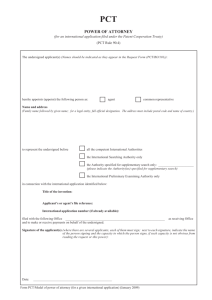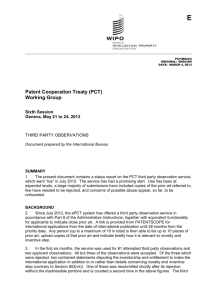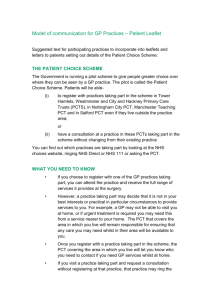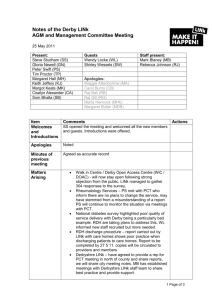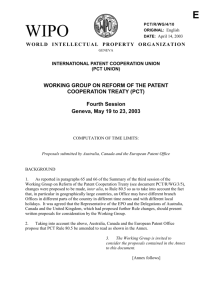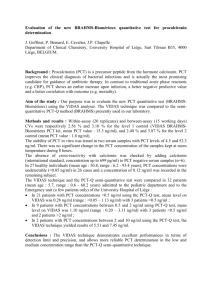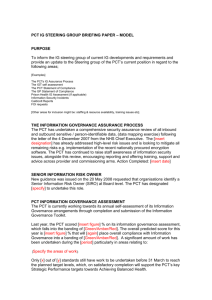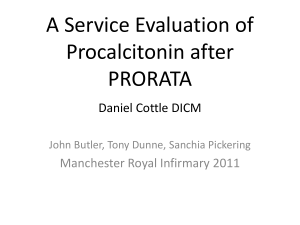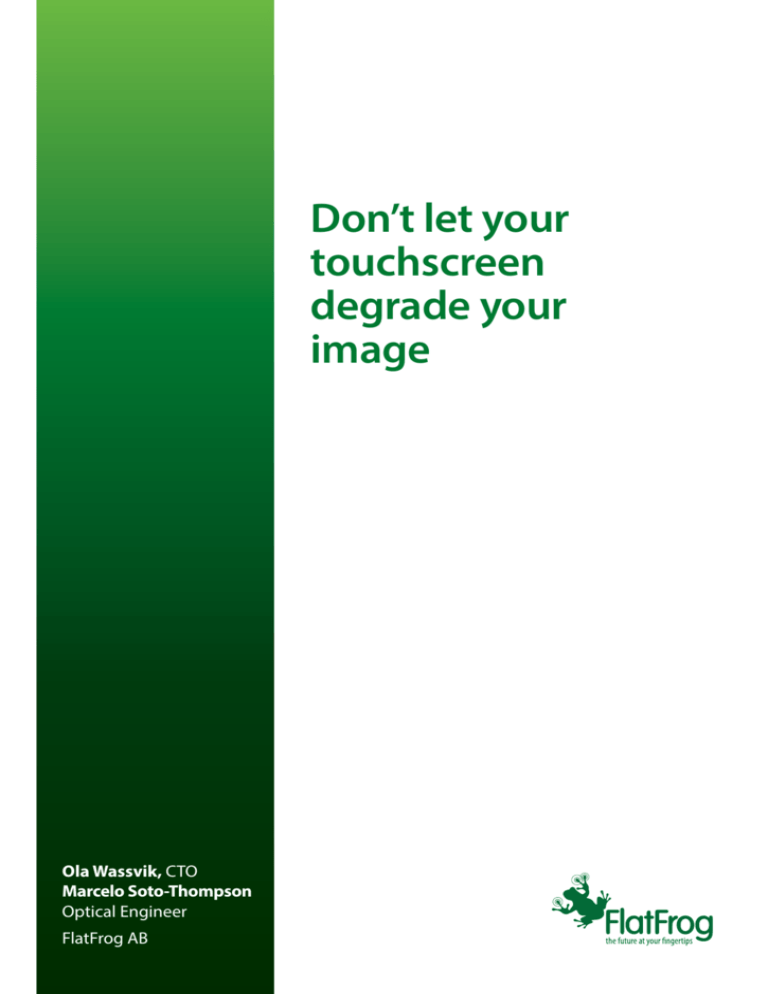
Don’t let your
­touchscreen ­
degrade your
image
Ola Wassvik, CTO
Marcelo Soto-Thompson
Optical Engineer
FlatFrog AB
1 Don’t let your touchscreen degrade your image (February 2015)
Whitepaper Ola Wassvik, CTO Marcelo Soto-­‐Thompson, SR Opt. Eng. FlatFrog AB Don’t let your touchscreen degrade your image Introduction The growing market penetration of Ultra High Definition (4k and 8k) displays creates a rapidly Abstract developing market requirement for display solutions This whitepaper explores the impact of that support the highest possible optical clarity. As LCD optical quality for touch-­‐enabled display resolution increases, the visual imperfections displays b ased on Projected Capacitive introduced by a display’s touch system – traditionally (PCT) and Frustrated Total Internal one of the primary contributors to lack of optical Reflection (FTIR), the latter of which clarity – become increasingly obvious. The superior includes FlatFrog InGlass™ touch. visual quality of touch displays incorporating FlatFrog InGlass™ touch, compared to legacy touch Touchscreens are becoming main-­‐
technologies such as Projected Capacitive (PCT), touch stream in all display sizes ranging from can be clearly observed. Whereas PCT requires an mobile phones to interactive white electrically conductive grid to be placed in front of the boards. However, system designers display, InGlass™ touch places a piece of ultra-­‐clear must take into account the trade-­‐offs non-­‐patterned glass between the user and the display. in optical quality based on their choice Since conductive materials are inherently poor at of touch technology. This paper transmitting light, the use of such materials by legacy highlights the advantages of InGlass™ touch technologies like PCT impedes optical quality. touch, specifically its ability to Some electrical materials have better optical qualities maintain superior visual clarity of the than others. For example, indium tin oxide (ITO) has a underlying display while providing high very high refractive index yet is quite transparent. multi-­‐touch performance across all However, ITO is only suitable for smaller display sizes. sizes and form factors. On the other hand, copper/silver, used in metal mesh (MM) touch for larger sizes is completely opaque. Because they both affect the image quality of the display, the extent of the effect must be well understood by OEMs and display integrators as they build increasingly larger interactive touch systems. Optical Quality There are several aspects to consider when determining the optical quality of a display image, notably: •
•
•
•
•
•
Visible lines Haze & clarity Contrast & resolution Transmission & color reproduction Haze caused by smudges on the screen Use of coatings – Anti-­‐reflection (AR) vs. Anti-­‐glare (AG) In this paper we will elaborate upon the differences between InGlass™ touch displays and PCT touch displays, and upon the relative impact on optical quality of the two touch technologies. FlatFrog AB 2 Don’t let your touchscreen degrade your image (February 2015)
Visible Patters with Metal mesh-­‐based PCT Solutions Visible lines in metal mesh PCT touch panels are especially prevalent in larger displays, negatively impacting the visual experience. From the touch performance perspective, it is important to minimize the resistance of the electrically conductive grid, which increases the thickness of the conductive leads. As an example, with metal mesh PCT solutions the electrically conductive grid can be clearly seen by the naked eye over the entire display. Significant design time and focus has to be invested to match the metal mesh pattern with the type of underlying LCD. This further limits the options for selecting multiple sources for the LCDs for the OEMs. In addition, the fine line geometries require expensive equipment, and the technology is also susceptible to yield issues with line breakage. Therefore, although the market has seen several announcements for MM-­‐based touch technologies, few success stories in the end-­‐market have actually been produced. FlatFrog InGlass™
METAL MESH PCT
Figure 1: FlatFrog InGlass™ touch (left) vs metal mesh PCT (right). Even for a medium size screen (23”) the grid of the metal mesh cover glass can be clearly seen by the naked eye. Image size: 4 x 7 mm. Haze and Clarity Haze is defined as a wide-­‐angle scattering of light, i.e. an image with high haze becomes washed out and looks milky. Clarity is defined as a narrow-­‐angle scattering of light, i.e. in an image with low clarity it is difficult to perceive details, text is difficult to read and lines are blurred. Haze and Clarity have been measured using the BYK Gardner Haze-­‐Gard plus. Measurements by Europtec Gmbh [2] and Ansinimov et.al.[1] , and description of Haze and Clarity are taken from the BYK manual [3]. Washed out image across wide area Blurred details per object Figure 2 Visualization of Haze and Clarity (modified) from BYK Haze-­‐guard plus manual [3] FlatFrog AB 3 Don’t let your touchscreen degrade your image (February 2015)
As can be seen above, both Haze and Clarity are important for image quality. Typically, clarity is judged more important for the appearance of the image, as the lack of clarity washes out details. However, both hazy images and images with low clarity can be strenuous to the human eye over long periods of time. The figure below compares the Haze of InGlass™ touch to the PCT alternatives, which produce between 5 and 30 times more haze than the FlatFrog solution. 3.0% 3.0% 2.0% Haze 2.0% 1.3% 1.0% 1.0% 0.6% 0.1% 0.0% FlatFrog InGlass™ Carbon Nanobud PCT ITO PCT MM PCT (Silver) MM PCT (Copper) Silver Nanowire Figure 3: Haze of touch module As depicted in the following figure, the InGlass™ solution is the only touch solution that can enable images with 100% clarity. Other touch solutions degrade the clarity of the displayed image resulting in an impaired user experience. 100.0% 100.0% 99.6% 99.2% Clarity 99.0% 98.5% 97.8% 98.0% 97.0% 97.0% 96.0% FlatFrog Carbon InGlass™ Nanobud PCT ITO PCT MM PCT (Silver) MM PCT (Copper) Silver Nanowire Figure 4: Clarity of touch module The combined impact of both Haze and Clarity can result in a significantly degraded viewer experience in systems that incorporate the non-­‐FlatFrog touch solutions depicted above. FlatFrog AB 4 Don’t let your touchscreen degrade your image (February 2015)
Contrast and Resolution Resolution and Contrast of different cover glasses are demonstrated in the images below. Here we compare the FlatFrog InGlass™ solution with Anti-­‐Glare (AG) treated cover glass, ITO PCT and metal mesh PCT. These panels are tested with both normal office illumination and high (20 klux) illumination levels. The target used is a standard 1951 US Air Force (USAF) resolution target with the modulation transfer efficiency measured at 50% (MTF 50%). The resulting measurement value is measured in line pairs per millimeter (lp/), which means that we can tell how many line pairs per millimeter it is possible to resolve when putting the touch module in front of the 1951 USAF resolution target. A higher value is better. The following figures show that the InGlass™ solution produces very little contrast degradation whereas ITO PCT, Metal mesh PCT, and AG all produce a larger negative impact on contrast. No glass
FlatFrog InGlass™
AG 100
ITO PCT
METAL MESH PCT
Figure 5: High-­‐resolution target at low ambient lighting (1 klux) captured behind various cover glasses. Left to right: No glass, FlatFrog InGlass™, AG treatment only, ITO PCT, METAL MESH PCT. Image Size: 1.1 x 1 mm. No glass
FlatFrog InGlass™
AG 100
ITO PCT
METAL MESH PCT
Figure 6: High-­‐resolution target in high ambient lighting (20 klux) captured behind various cover glasses. Left to right: No glass, FlatFrog InGlass™, AG treatment only, ITO PCT, METAL MESH PCT. Image Size: 1.1 x 1 mm. Touch Module Low illumination High illumination lp/mm DPI lp/mm DPI FlatFrog InGlass™ 30.0 1550 10.7 545 AG 100 19.2 970 7.8 400 ITO PCT 21.3 1080 5.8 295 Metal mesh PCT (Copper) 23.1 1175 6.5 330 Table 1: Displaying resolution limits of various cover glasses at different illumination levels. The resolution limit here is the point at which the contrast (MTF value) is 50%. FlatFrog AB 5 Don’t let your touchscreen degrade your image (February 2015)
In addition, for many commercial systems the PCT layer is combined with an Anti-­‐Glare treatment of the cover glass. In these situations, the contrast degradation becomes additive, resulting in even worse susceptibility to ambient light, see Table 1. As a result, expensive displays that incorporate this touch technology are in reality often not producing the specified resolution. The side benefit of using the heavy AG treatment is to hide the metal mesh lines but it comes at the high cost of deteriorating LCD image quality. The other benefit that users may perceive with AG treatments is the smoother touch feel on the glass. However, there are better ways of compensating for the smooth touch, such as standard coatings available with InGlass™ touch. FlatFrog InGlass™ touch module can produce as much as 30% higher resolution at low illumination and 65% higher resolution at high illumination. As a result, it is easier to read text and to see details on images when using a display that incorporates FlatFrog InGlass™ touch. Transmission and Color Reproduction The following figure compares the transmission spectra of FlatFrog FTIR touch glass to a range of commercially available PCT touch modules. FlatFrog’s InGlass™ touch solution provides consistently superior transmission to PCT across all wavelengths, while the FlatFrog ZG™ (Zero Air-­‐Gap) solution can provide near perfect transmission. The FlatFrog ZG™ cover lens is a double-­‐sided Anti-­‐Reflection (AR) coated cover glass with AFP coating that is placed with a minimal air-­‐gap towards the display. In the visible range, the AR coated FlatFrog InGlass™ ZG™ produces the highest transmission of all cover glasses. In addition, the FlatFrog InGlass™ solution enables exceptional color neutrality. 100
Transmission [%]
95
90
85
Flatfrog ZG™
Flatfrog InGlass™
80
ITO PCT
MM PCT
Silver Nano
75
400
500
600
Wavelength [nm]
700
800
Figure 7: Spectral transmission in the visible range of the FlatFrog cover glasses (Standard and ZG™) compared to commercially available PCT cover glasses, demonstrating the superior optical performance of the FlatFrog solution. The average transmission of a typical metal mesh PCT solution is 10% lower than a FlatFrog InGlass™ solution. To achieve the same luminosity with a PCT solution, backlight power must therefore be increased 10%. The larger the display, the more significant is the power savings. For example, a FlatFrog system can reduce the power consumption of a 65’’ high-­‐brightness display by up to 50W. FlatFrog AB 6 Don’t let your touchscreen degrade your image (February 2015)
Visibility of Fingerprints on Anti-­‐fingerprint vs. Regular Surfaces The ability to repel various types of smudges that accumulate during normal usage represents a significant, if indirect, contributor to the overall optical quality of a touch panel. Fingerprints represent the number one contaminant for touch panels. Therefore, there is high interest in reducing the amount of residue that a finger deposits at each touch. Typically, residue reduction is accomplished by applying some form of Anti-­‐Fingerprint (AFP) coating. The image below depicts how the coated glass prevents fingerprints from adhering to the touch panel. Over time, residual fingerprints will cause a substantial increase in the perceived haze of the touch panel. Consequently, all FlatFrog InGlass™ products incorporate a high quality AFP coating. FlatFrog InGlass™
METAL MESH PCT
Figure 8: Fingerprints on anti-­‐fingerprint coated FlatFrog InGlass™ (left) vs non-­‐coated METAL MESH PCT (right). Both fingerprints were deposited under identical conditions. Black background used in both images. Anti-­‐Reflection vs. Anti-­‐Glare Ambient light greatly influences the viewing experience. In order to reduce the impact of ambient light, an AG cover glass treatment is often utilized. The purpose of the AG treatment is to diffuse direct reflections. However, even in mild lighting conditions the AG treated cover glass scatters the light over a large area. As shown below, AG can greatly reduce the contrast on a large portion of the screen. An alternate way of reducing the impact of ambient light is to apply an Anti-­‐Reflection (AR) coating to the cover glass, such as in the Flatfrog ZG™ panel. The reflected light in the Flatfrog ZG™ panel only affects a small part of the image, resulting in a higher overall perceived contrast and a significantly improved viewing experience. FlatFrog ZG™
AG
Figure 9: FlatFrog ZG™ with AR coating (left), PCT cover glass with AG treatment (right), in office lighting (1 klux). FlatFrog AB 7 Don’t let your touchscreen degrade your image (February 2015)
As can be seen, the system with AG produces a washed out look when subjected to ambient light, whereas the FlatFrog ZG™ system with AR maintains its’ image quality. We can also see that the area completely saturated by the ambient light is larger in the system using AG compared to the one using AR. Therefore a larger part of the image is useable in a Flatfrog ZG™AR-­‐coated system. Conclusion As market demand continues to accelerate for interactive displays of all sizes with ultra-­‐high resolution, the need for touch solutions that do not negatively affect optical performance becomes increasingly critical. PCT touch technologies all have optical limitations that become more apparent as displays increase in resolution and screen size. FlatFrog’s InGlass™ FTIR touch solution provides a consistently superior visual experience across all screen sizes and resolutions by minimizing image haze and by maximizing image clarity, while producing the highest possible contrast and resolution. In addition, the FlatFrog Anti-­‐fingerprint treatment reduces display contamination while the Anti-­‐
Reflection coating used in the FlatFrog ZG™ glass panel even further enhances its superior optical performance compared to systems using only Anti-­‐Glare coatings. The advantages of FlatFrog InGlass™ touch are especially apparent in touch applications where optical image quality is essential, for example in personal computers and in the medical, digital signage and conferencing markets. The result is an enjoyable and longer color-­‐rich user experience that maximizes the OEM display investment. References 1. A. Anisimov et.al. “Printed Touch Sensors Using Carbon Nanobud Material”, SID Information Display, Vol. 30, No. 4 2. Measurement report from Europtec GmBH 3. BYK Gardner Haze-­‐gard plus manual FlatFrog AB 8 Don’t let your touchscreen degrade your image (February 2015)
Ola Wassvik, is the co-­‐founder and CTO for FlatFrog. Ola has specialized for a decade in developing optics-­‐based input systems for volume applications. Ola is responsible for the overall development of FlatFrog's proprietary technologies, and is one of the principal figures behind the company's key patents. He currently holds more than 25 patents. He holds a Master of Science degree in Engineering Physics from Lund University, Sweden. You may contact him at ola.wassvik@flatfrog.com. Marcelo Soto-­‐Thompson is a physicist and optical engineer with over 15 years of experience in the RnD of optical systems and techniques. He holds a Master of Science degree in Engineering Physics and PhD from Lund University, Sweden. You can reach him at marcelo.soto-­‐thompson@flatfrog.com. FlatFrog AB Traktorvagen, 11 SE-­‐226 60, Lund Sweden http://www.flatfrog.com FlatFrog AB, 2014. The information contained herein is subject to change without notice. Disclaimer: FlatFrog MAKES NO WARRANTY OF ANY KIND, EXPRESS OR IMPLIED, WITH REGARD TO THIS MATERIAL, INCLUDING, BUT NOT LIMITED TO, THE IMPLIED WARRANTIES OF MERCHANTABILITY AND FITNESS FOR A PARTICULAR PURPOSE. FlatFrog reserves the right to make changes without further notice to the materials described herein. FlatFrog does not assume any liability arising out of the application or use of any product or module described herein. FlatFrog does not authorize its products for use as critical components in life-­‐support systems where a malfunction or failure may reasonably be expected to result in significant injury to the user
FlatFrog AB Copyright © 2015 FlatFrog Laboratories AB. All rights reserved.
Traktorvägen 11
226 60 Lund
Sweden
Tel: +46 46 10 25 00
Fax: +46 46 10 13 61
info@flatfrog.com
www.flatfrog.com

